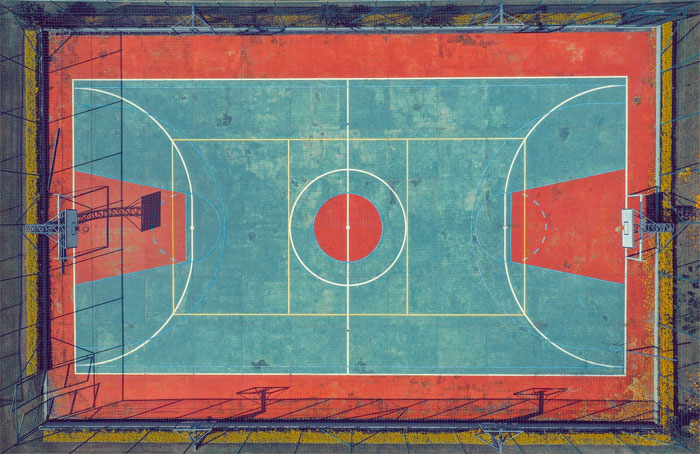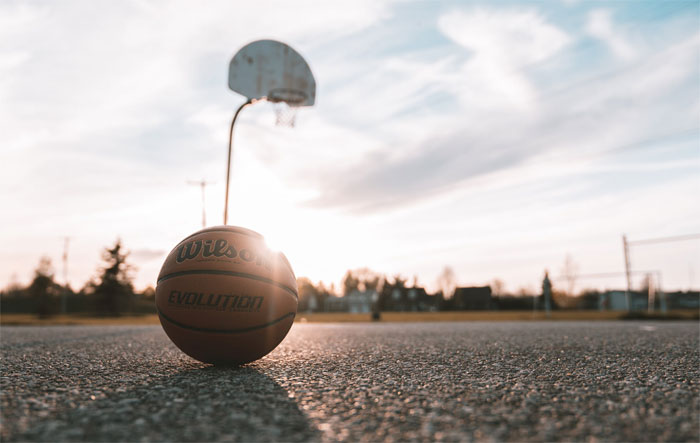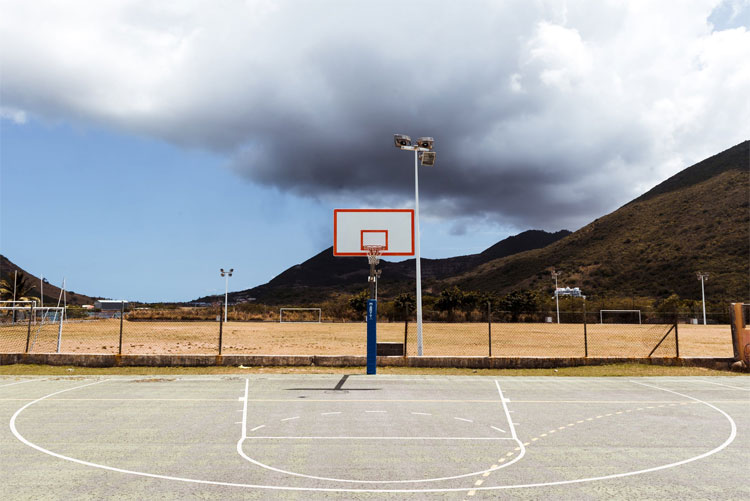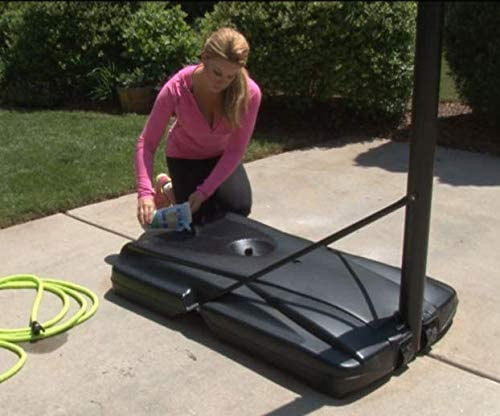Are you looking to add a basketball court to your backyard? If yes, then you are at the right place.
If you come from a family that loves basketball, you may already own a basketball and a team name. There is only one thing left – a basketball court.
If this is the case, establishing a ballpark figure for the cost of a backyard basketball court is a good place to start. And, if the expense concerns you, rest assured that it is not as high as you may believe.
So, how much does it cost to build a basketball court in your backyard? Before we get into the specific expenses, let's have a look at the items you'll need in place.
Basketball Court Dimensions
The size of the court you want to build is a decision you can't escape when working on a backyard basketball court. They come in a variety of sizes to accommodate different leagues and levels of play.
The best court for you will be determined by your preferences, budget, and backyard space.

So, what are the various basketball court dimensions that you can work with? You may choose between full and half-courts. Let's have a look at the exact metrics for each:
Full-Size Courts
- A standard NBA full-size court measures 97 by 50 feet
- A high school full-size court measures 84 by 50 feet
- A junior high school full-court measures 74 by 42 feet
Half-Size Courts
- A standard NBA half-size court measures 47 by 50 feet
- A high school half-size court measures 42 by 50 feet
- A junior high school half-court measures 37 by 42 feet
- A 3-on-3 court measures 30 by 30 feet
Half-courts are incredibly convenient for individuals with a limited budget and space.
Once you have decided on the right basketball court size to suit your needs, the next big and equally important decision is the base material for use.
Let's look at the factors to consider when selecting a backyard basketball court base and the various options available.
Factors To Consider When Selecting A Backyard Basketball Court Base
Durability
A basketball court should last for at least five to ten years. A durable choice will resist foot traffic, harsh weather conditions, and everything else you throw at it.
We recommend going for a flooring choice that is UV-resistant, can tolerate continuous contraction and expansion, and can withstand freeze and thaw cycles.
Surface Friction
Excessive friction can impede a player's mobility, which can have a detrimental influence on their performance. On the contrary, if there isn't enough friction, they may glide about needlessly.
To prevent users from slipping and injuring themselves, the court flooring you pick should have optimal surface traction. The finish of the floor is an essential factor to consider when it comes to friction.
Shock Absorption
Shock absorption is another critical factor in the functioning of a basketball court floor.
Excellent shock absorption is vital for safety and helps minimize player fatigue, allowing you to use your court for extended periods without feeling stressed. Trust us; your joints will thank you.
Perforations
Due to severe weather conditions, such as rain, an outdoor basketball court will require adequate drainage.
You'll need to add a perforated alternative that allows water to pass through to prevent pooling, so your court may be used without fear of accidents when it rains.
Ball Bounce
Make sure you choose a floor that won't affect the ball's rebound. The game and performance will both be compromised by a lower ball bounce.
Installation
Another essential factor to consider is the method of installation. You want something simple to put up, like a snap-together tile that you can install yourself without the aid of a professional.
Maintenance
If you have the option, select a flooring material that requires minimal upkeep. This will make things easier for you and ensure that you don't have to spend a fortune to keep the floor looking good.
You'll also have to keep the court clean and free of dust and grime, which may be difficult with an outdoor court.
What Are The Common Basketball Court Flooring Options?
Asphalt Court
Asphalt is the most cost-effective and easy-to-maintain basketball court flooring choice. However, extreme temperatures, such as ice, can cause it to crack.
The price of asphalt varies from $1.75 to $4 per square foot.

Blacktop Court
Blacktop is nearly identical to asphalt and costs the same ($1.75 to $4 per square foot). It is, however, a little rougher and more durable, making it ideal for outdoor courts.
You'll also like how simple it is to maintain.
Concrete Court
Because of its sturdiness, concrete flooring is the most popular choice, especially in the harsh elements of an outdoor court.
On the downside, it is more difficult to maintain, making it unsuitable for frequent usage. It also works well in hot weather, although it does not fare well in cold temperatures without a protective cover.
A concrete basketball court can cost anything from $2 to $5 per square foot to install.
Sports Tiles
Installation is a breeze because of the snap-together tiles. They're also low-maintenance and adaptable, making them a great option for an outdoor basketball court.
In addition, tiles are convenient because you simply need to remove the afflicted tile in the event of damage. However, the disadvantage is that they are quite slippery and increase the chance of injury.
The cost of court tiles ranges from $3 to $7 per square foot.
Rubber Floor
Rubber flooring is also an excellent choice for outdoor basketball courts.
Even though they will need to be resurfaced every seven years or so, you will appreciate how comfortable they are and how long you can play without hurting your ankles.
You can expect to pay between $4 and $8 per square foot for a rubber floor.
Laminate Flooring
If you want conventional basketball courts but don't have a huge budget, you can go for a laminate floor. You'll like how low-cost, simple-to-install, and easy-to-maintain they are.
However, if you want it to last longer, you'll have to put a protective cover over it.
The price of a laminate floor ranges from $4 to $6 per square foot.
Laminate flooring is common for indoor basketball courts.
Hardwood Floor
You're surely familiar with a maple hardwood floor if you're a basketball enthusiast. Hardwood provides a stylish, high-performance playing surface that you will enjoy. However, the material and maintenance costs will be considerably higher.
In addition, since you'll be installing it outside, you'll also need a protective cover to safeguard it from the weather.
The cost of a hardwood basketball court is about $6 to $10 per square foot.
Hoop Installation
The hoop, which comes in various forms and costs, is the next step once you've decided on the flooring option. To make it easier to choose the appropriate hoop for you, make a list of the key characteristics you desire.
Let's have a look at the standard hoops you can choose from:
Common Basketball Hoop Types
In-ground Hoops
For in-ground hoops, the poles are placed approximately 2 feet into the ground and covered with concrete, making them more stable. They're a pain to set up, but they're the best option if you want a hoop that can survive intense games.
The price varies based on the material of construction, the rim, backboard, pole, and brand.

Portable Hoops
The convenience of a portable basketball hoop is unrivaled. Most people choose them since they are simple to install and transport.
Portable hoops are better for you if you want to move the hoop about or don't have a permanent living situation and will be moving out soon.
Don't worry if you're concerned about their stability. To make it more sturdy, fill its base with liquid or sand. Other alternatives even allow for the addition of heavy materials like bricks to increase the weight.

If you choose a low-cost option, though, you will have to deal with a flimsier hoop than its wall-mounted and in-ground counterparts.
Wall-mounted Hoops
Wall-mount hoops, while not common, are easy to set up and sturdier than portable hoops. It's also the easiest way to transform your garage or any other space in your house into a basketball court.
Marking and Painting a Backyard Basketball Court
Some surfaces may arrive pre-marked if you're lucky. However, if you want to paint the lines on your basketball court, you'll have to invest a little more money.
With the aid of a basketball court layout guide, you can do it yourself. Alternatively, you may pay a professional around $400 to do it for you.
Accessories For A Backyard Basketball Court
An outdoor court allows you to experiment with different accessories to create a courtyard that you will enjoy spending time in.
Of course, the add-ons you choose will be influenced by your budget and, to some extent, the space you have available.
Let's have a look at some of the accessories you can add to your outdoor basketball court to make it even better:
Fence
If you've ever had to deal with a run-away basketball, you'll agree that a fence is more of a need than a luxury.
It saves you time hunting down the ball and is also ideal if you want privacy. You may have to spend up to $3,000.
Ball Containment
Ball containment features allow you to spend more time playing your favorite sport instead of chasing after stray basketballs on the road, in bushes, or over the fence to your neighbor's house.
Thanks to the numerous possibilities available on the market today, you can be sure to find an excellent solution that is both aesthetically pleasing and effective.
Rebounder Net
Rebounders return the ball to you, allowing you to practice whenever you want, even if you're alone. If you want a quick and easy way to hone your skills, you'll need to install one of these in your backyard basketball court.
A ball return system will require you to spend around $300.
You might also like: Best Basketball Rebounding Machine for Fastest Ball Return
Lighting

Who said you have to limit yourself to playing during the day? Install lighting on your backyard court to let your family and friends enjoy the game at any time of day or night.
It will cost you around $1,500 on average, although this can vary greatly depending on the style and quantity of lights you pick.
You might also like: Best Basketball Hoop Lights to Brighten Up Your Night Games
Seats
If you want to go all out, adding seats to your basketball court is a great idea. If you enjoy competitive matches, courtyard chairs will provide an accessible spot to take a break as well as a space for your guests.
The price varies depending on the type of seat.
Court Bubble
A court bubble is ideal if your basketball court needs additional protection from the elements, such as rain and ice. It will safeguard your valuable floor, such as hardwood flooring, while also allowing users to have fun anytime they want.
A court bubble costs around $20,000 on average.
How Much Will I Spend On Building A Backyard Basketball Court?
By now, you should have a rough estimate of how much your backyard basketball court will cost. But let's take a look at what a full-court spanning 97 feet by 50 feet would cost on average.
- Site Preparation: $4,850
- Flooring: $29,000
- Hoops Installation: 3,000
- Line Markings: $400
- Labor: $15,000
- Permit: $300
- Total: $52,550
It's important to remember that the price is an estimate. It may change based on the type of material used, the amount of land preparation needed, drainage, labor expenses, and permit fees, among other factors.
If you add extras like fencing, rebounder nets, lights, and more, you'll need to spend more. On the other hand, you may be able to save some money if you choose a DIY backyard basketball court.
Final Words
There you have it – a place to practice, replay the killer moves of your best player and have fun with your family. It doesn't get better than that, for sure.
According to our estimates, a backyard basketball court costs around $52,550, but you can spend as much as $17,000 on the low-end to $76,000 on the high-end. And if you are looking at a 3-on-3 court, $9,000 should suffice.
You can also choose to add cool accessories such as rebounder nets.
You might also like: Best Backyard Basketball Hoops for Shooting Goals at Home

